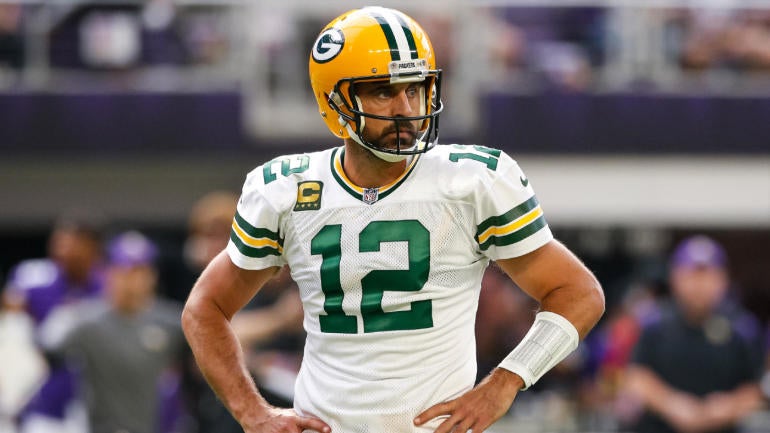
One of the most surprising developments of Week 1 was the near-total inability of the Green Bay Packers' offense to get anything going. Aaron Rodgers and Co. managed just seven points, turning only one of their 11 drives into a score against the division rival Minnesota Vikings -- a team that finished last season 24th in yards allowed and 30th in points allowed.
It's worth digging into what exactly happened to a unit that, while it no longer has Davante Adams, still came into the season with high expectations for efficiency and explosiveness behind Rodgers, a strong offensive line and running back duo, and head coach Matt LaFleur.
The first thing worth noting is that the offensive line was not in its expected shape, and it showed. Both David Bakhtiari and Elgton Jenkins missed the game due to injury, leaving the Packers working with backups at left and right tackle. Yosh Nijman and Royce Newman started in their places, and contributed to an overall poor showing up front. The run blocking on the perimeter was not up to snuff, and the Packers tried to run to the perimeter more often than up the middle behind the inexperienced trio of Jon Runyan (and later Zach Tom), Josh Myers and Jake Hanson.

Pick Six Newsletter
Crafted By The Best NFL Experts
Get the day's big stories + fun stuff you love like mock drafts, picks and power rankings.
Thanks for signing up!
Keep an eye on your inbox.
Sorry!
There was an error processing your subscription.
With the exception of a 29-yard jaunt on which Aaron Jones was largely untouched until he was way downfield, Green Bay's run game looked rather pedestrian for much of the afternoon -- and that's despite not a single one of the team's rushes coming against an 8-man box. Rodgers wasn't under pressure at an incredibly high rate, but a significant percentage of his pressured dropbacks resulted in sacks. After taking a sack just 15 and 20 percent of the time he was pressured the past two seasons, Rodgers was sacked four times on 11 pressured dropbacks last Sunday.
Those takedowns contributed to Rodgers finishing 27th among the league's 32 starting quarterbacks in Expected Points Added (EPA) per dropback, according to TruMedia. He also completed only 22 of 34 passes for 195 yards and an interception while taking the aforementioned four sacks and having another pick dropped by a Vikings defender. He could not find anything remotely down the field, with his average throw traveling only 5.59 yards in the air -- a figure far south of the 7.69 and 7.84 he averaged over the previous two seasons.
The Vikings played zone coverage on 77 percent of passing snaps, per TruMedia. That's a significant rate increase from the 61 percent zone coverages the Packers saw in each of the last two seasons. That contributed to Green Bay's inability to get the ball downfield through the air. Rodgers attempted just two passes 20 or more yards down the field, and one of them was a prayer chucked into the secondary late in the first half and that got intercepted. The other deep pass came on the game's opening play, where he found Christian Watson streaking down the sideline for what should have been an 80-yard touchdown, but was instead a very ugly drop.
Even on the occasions where the Packers tried to smash the easy button the way they would in previous seasons, things did not work out very well. Because instead of Adams running the routes, it was Watson, Romeo Doubs, Sammy Watkins, Randall Cobb, and Juwann Winfree. Plays that used to result not just in easy completions, but free yards, instead got blown up at or near the line of scrimmage as the rookies and subpar veterans struggled to execute at the same level as Green Bay's departed All-Pro.
The inability to get the ball down the field, combined with the ineffectiveness of the short stuff, led to Rodgers trying to force things that weren't there. He flung the ball into tight coverage multiple times, including on what ended up being the most consequential offensive play of the game, where he tried to hit Robert Tonyan on a seam route despite that fact that he was blanketed by Eric Kendricks and Camryn Bynum.
The overall ineptitude of the passing game contributed to the lack of opportunity for Jones -- the team's most explosive playmaker now that Adams is no longer in town.
He was targeted five times, with the passes resulting in three catches for 27 yards. With his five carries, that gave him only eight touches on the day. Those touches yielded 76 yards, though, an average of 9.5 a pop. LaFleur admitted after the game that the eight touches were not enough, and if he's going to be the only one consistently creating explosive gains, that's almost certainly true. It's not as though AJ Dillon did poorly with his chances, however. He turned 10 carries and five catches (on six targets) into 91 total yards, an averaging of 6.1 per touch. But where Jones had a 22-yard catch and 29-yard run, Dillon's longest gain of the day was 14 yards. He was more of a guy keeping the rock moving bit by bit, rather than creating chunk plays. Without a premier perimeter passing-game option, the Packers have to keep in mind that while it's important for Dillon to be heavily involved, they can't lose sight of Jones' ability to create big plays.
Green Bay's opponent this Sunday night is one that Rodgers has repeatedly torched over the years: The Chicago Bears. Adams obviously played a significant role in those thrashings, though, and he's no longer around. Perhaps the return of Allen Lazard to the lineup will change things, if he's fully recovered from his ankle injury. Perhaps simply seeing those dark blue helmets with the burnt orange "C" on them will make things snap back into place.
It's possible, maybe even likely, that we'll look back in Week 1 as an aberration, the same way we did when the Packers struggled badly against the New Orleans Saints last year. But taking a player like Adams out of the offense doesn't just get fixed by the passage of time from one week to the next. Green Bay needs to get its offensive line back in correct shape, its rookie receivers to play at a higher level, and its star quarterback to be content taking what the defense gives him until the opportunity to take more.

















